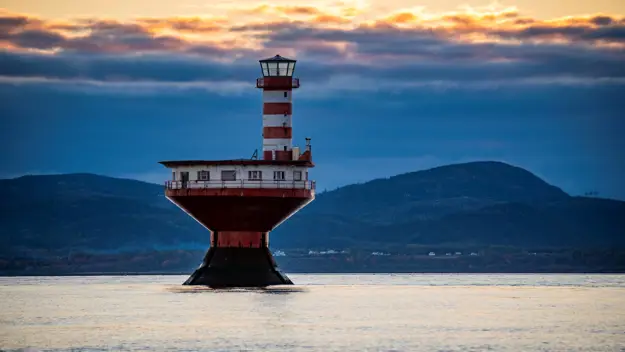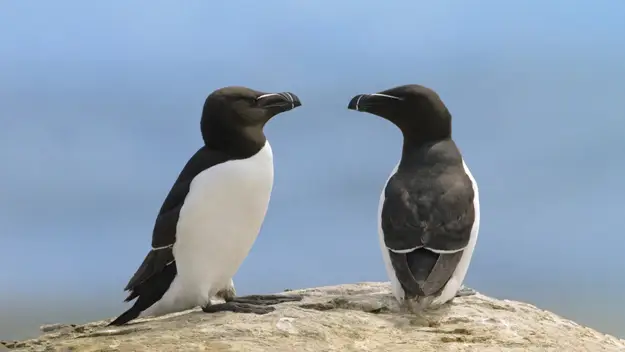The blue whale… most of us know its impressive size, but what do you really know about this majestic mammal? Did you know it’s possible to observe them right here in the Saguenay–St. Lawrence Marine Park?
A giant among giants, its mere appearance at the surface of the water is breathtaking. Whether you’re preparing for your next whale watching cruise or simply want to learn more, here are 10 fascinating facts about the blue whale you probably didn’t know.
1. It’s the largest animal on Earth
The blue whale is undeniably the largest animal alive today! It can reach 30 meters (98 feet) in length—the equivalent of three school buses lined up—and weigh up to 170 tonnes (375,000 lbs), about 25 times the weight of an adult elephant. To give you a better idea, imagine a 10-story building lying horizontally on the water: that’s roughly the size of an adult blue whale!
Of course, with that size comes enormous organs: its tongue alone weighs as much as an elephant! Its heart is about the size of a small car and can weigh nearly 600 kg. With each beat, it pumps roughly 220 liters of blood throughout the whale's body. Definitely makes us feel very small! 😄
 Photo: Illustration by Alberto Gennari
Photo: Illustration by Alberto Gennari
2. The blue whale isn’t really blue
Contrary to its name, the blue whale isn’t really blue — its skin is actually a pale gray. So why is it called a “blue” whale? The answer lies in a fascinating optical phenomenon.
Underwater, light behaves differently than in the air. Colours like red, yellow, and green are absorbed quickly, while blue penetrates much deeper. The whale’s light-colored skin reflects this ambient blue light, giving the illusion of a blue hue. This illusion fooled explorers and scientists for centuries… and earned the whale its name!
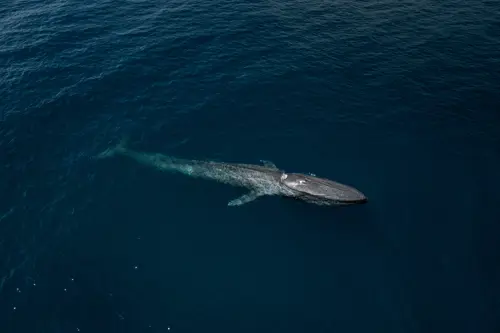
3. Its baby is called a calf
Yes, “calf” doesn’t just refer to baby cows! Newborn or young whales are also called calves. The term also applies to other large mammals, like elephants, camels and giraffes, just to name a few
The blue whale is a placental mammal, meaning the fetus develops in the mother’s uterus, just like humans. However, gestation lasts about 10 to 12 months—after all, they are growing a much larger baby! At birth, the calf measures 6 to 7 meters and weighs nearly 6,000 lbs. Immediately after birth, it rises to the surface to breathe, assisted by its mother.
The calf feeds exclusively on its mother’s rich milk, which contains 30–40% fat. It can drink up to 200 liters per day, gaining up to 220 lbs daily! Weaning occurs around 7–9 months, when the calf reaches about 15 meters. Females give birth to a single calf every two or three years.
4. The loudest animal on the planet
Yep, the loudest animal isn't the rooster, lion, or elephant—but the blue whale! Its call can reach 180 to 188 decibels, louder than a rocket launch! Fortunately for us, these sounds are infrasound, so most of the time we can’t hear them.
Whale vocalizations can travel over 1,600 km underwater, allowing them to communicate over long distances, navigate the ocean, or attract a mate. The blue whale’s song consists of pulses, moans, and cries, each with a specific role. Some studies suggest variations in songs can differentiate subpopulations or mark territories, though many aspects of whale song remain mysterious.
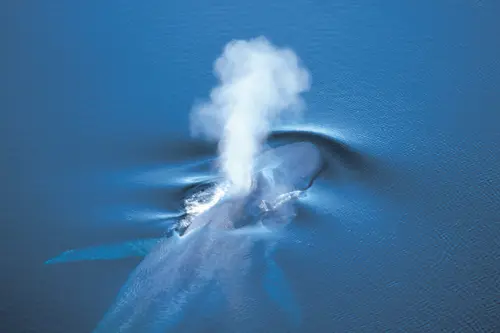
5. We can determine its age by its earwax
Weird, right? Just as we count tree rings, scientists can estimate a blue whale’s age by examining its earwax! A new layer of wax forms every six months, and by counting them, researchers can determine a fairly accurate age.
Blue whales can live about 80 years, comparable to humans and most other whale species. Females reach sexual maturity around 10 years, and males around 12. Longevity often correlates with age at maturity, birth intervals, and parental care: long-lived animals reproduce late, have few offspring, and care for them over long periods.
6. It’s an endangered species
Like many whales, the blue whale was heavily hunted for centuries. The rise of commercial whaling in the early 20th century caused its population to plummet. Even after whaling ended around 1950, populations have not fully recovered.
Today, threats still exist such as pollution, entanglement in fishing gear and climate change affecting food supply (krill).
Since 1996, blue whales have had worldwide protection through the International Whaling Commission. In Canada, they’ve been officially endangered since 2002. Fisheries and Oceans Canada has implemented a long-term strategy to bring the Canadian population to at least 1,000 adult whales.
Blue whales remain fragile giants, and their survival depends on our efforts to protect habitats and reduce threats.
 The blue whale “Jaw-breaker,” seen in September 2025 in the Saguenay–St. Lawrence Marine Park (photo credit: Baleines en direct).
The blue whale “Jaw-breaker,” seen in September 2025 in the Saguenay–St. Lawrence Marine Park (photo credit: Baleines en direct).
7. It has no teeth
Blue whales don’t have teeth. Instead, they have baleen, an ultra-efficient filtration system. Baleen consists of long, flexible plates made of keratin, the same material as nails and hair. They’re brown or black and lined with bristle-like fibers, perfect for filtering tiny crustaceans.
The whale opens its mouth and takes in thousands of liters of water, then pushes it out through the baleen using its tongue. The water exits, while krill is trapped—efficient, right?
Adult blue whales can eat up to 35,000 lbs of krill per day, about 12% of their body weight. Calves are born without or with very small baleen to nurse safely. By 6–12 months, the baleen is fully functional.
8. It doesn’t drink water
As explained in the previous fact, when feeding, whales take in huge amounts of water, but they only keep the krill—all the water is expelled. That is because just like us, blue whales cannot drink saltwater or they’d dehydrate.
Instead, all their water comes from food: krill contains enough moisture to hydrate the whale. Their powerful kidneys also extract salt and conserve water, a natural efficiency system allowing them to thrive in the ocean. Living in water also means they need much less hydration than land animals. Yet another reminder that nature always knows best!
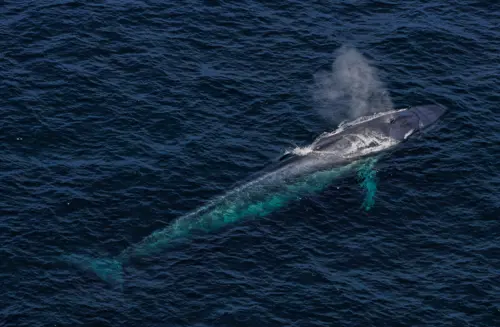
9. It can stay underwater for up to 30 minutes
Holding your breath for 30 seconds at the pool feels like a lot? Blue whales can dive for up to 30 minutes without surfacing!
Typical dives last 10–15 minutes, but longer dives can reach half an hour—necessary for reaching cold, deep waters where krill swims. When surfacing, they take several deep breaths, spouting air spectacularly, then dive again.
Their secret isn’t just lung size: they exchange 80–90% of the oxygen in their lungs per breath, compared to our 10–15%. Yep, whales are definitely winning the breathing-efficiency contest! 😄
10. It’s found in all oceans
The blue whale is a true world traveler, found in every ocean from the North Pole to the South Pole. However, that doesn’t mean they’re everywhere at once: they are seasonal migrants.
In summer, they head to cold, krill-rich waters, like in the Saguenay–St. Lawrence Marine Park. In winter, they move to warmer waters to reproduce.
Over a lifetime, a blue whale can travel tens of thousands of kilometers. On a single migration, it may cover 10,000 km. In one day, it can swim up to 50 km to find krill, its main food source. Kind of puts our trip to the grocery store in perspective!

